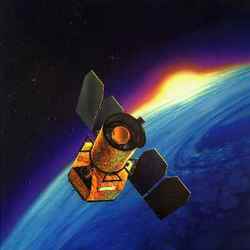
GALEX , one of the telescopes that will study AE Aqr. Image credit: NASA Click to enlarge
Amateur astronomers are being asked to help a constellation of observatories unravel the mysteries of a puzzling binary star system.
On August 30-August 31, 2005 two space-based and four professional ground-based observatories are scheduled to observe the cataclysmic variable star AE Aqr. Each of the observatories covers a different wavelength of light and amateur astronomers have been asked to help cover the visible-light portion.
“This observing campaign will take place over nearly a full day, and since no single ground-based observatory can observe AE Aqr for that long due to Earth’s rotation, amateur astronomers can make a unique and invaluable contribution to this campaign,” said Dr. Christopher Mauche of Lawrence Livermore National Laboratory, the principal investigator of the project.
Because they are spaced all across the globe, amateur astronomers can observe this star and other celestial objects unhindered by nightfall or weather.
The Chandra and GALEX space telescopes will be working with the HESS, MAGIC, VLT, and VLA ground-based telescopes. Combined, they will provide coverage of AE Aqr from high-energy gamma-rays to low-energy radio waves. Such simultaneous multiwavelength coverage is required to provide the clearest picture of the locations, mass motions, energetics, and inter-relationships of the various emission regions in the star.
AE Aqr is an intermediate polar, a type of cataclysmic variable star. It actually consists of two stars – a red dwarf and rapidly spinning magnetic white dwarf. Material drawn off the red dwarf falls toward the white dwarf, but instead of landing on the white dwarf surface, it is flung out of the system by the white dwarf’s rapidly spinning magnetic field. This mechanism, which is uncommon but not unique to AE Aqr, is referred to as a magnetic propeller.
“Amateurs astronomers have been observing AE Aqr since 1944. Since then, they have recorded over 28,815 measurements of the star, most of them made with just a telescope and their eyes. This type of historical data is immensely valuable in studying variable stars and only amateurs can provide it,” Dr. Arne Henden, Director of the American Association of Variable Star Observers (AAVSO), said.
Amateur astronomers are being asked to observe AE Aqr every night possible until September 3. Those with CCD cameras on their telescopes are requested to make scientific brightness measurements, known as photometry, of the system as well. For information on how to measure the brightness of AE Aqr and submit results to professionals, visit the AAVSO web site at http://www.aavso.org/alertnotice .
The AAVSO is the world’s preeminent professional-amateur astronomical association. Specializing in the study of variable stars, the AAVSO’s International Database has over 11 million observations of variable stars dating back over 100 years. Founded in 1911 as part of the Harvard College Observatory, the AAVSO became independent in 1954 and currently has over 3,000 members and observers in over 40 countries.
Original Source: AAVSO News Release

This topic is quite trendy on the Internet right now. What do you pay attention to when choosing what to write about?